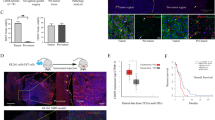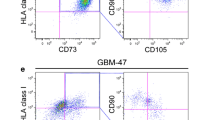Abstract
To investigate the tumor-initiating cells (TICs) in rhabdoid meningioma (RM), a population of CD105-positive cells isolated from a fresh RM surgical sample was analyzed for proliferative activity, self-renewal ability, tumorigenic ability, multilineage differentiation potential, as well as chromosomal aberrations. The results showed that isolated CD105-positive cells could be maintained for more than 50 generations in vitro. These cells exhibited increased proliferative activity and single-cell tumor sphere-formation ability compared with CD105-negative cells. In vivo experiments showed that CD105-positive cells possessed much greater potential to reconstitute the original human RM in nude mice as compared with CD105-negative cells. Phenotypically, CD105-positive cells shared some surface markers with mesenchymal progenitor cells (MPCs), but karyotype analysis showed chromosomal abnormalities characteristic of malignant meningioma, thus distinguishing them from supportive stroma-derived MPCs. In addition, in contrast to CD105-negative cells, CD105-positive cells could differentiate into adipocytes and osteocytes in response to specific induction agents. Finally, CD105-positive cells with stem-like features were also isolated from xenograft tumors. In conclusion, a population of CD105-positive TICs with some traits of MPCs was identified in RM and might provide a promising therapeutic target in management of malignant meningioma.








Similar content being viewed by others
Abbreviations
- RM:
-
Rhabdoid meningioma
- VIM:
-
Vimentin
References
Kim EY, Weon YC, Kim ST, Kim HJ, Byun HS, Lee JI, Kim JH (2007) Rhabdoid meningioma: clinical features and MR imaging findings in 15 patients. AJNR Am J Neuroradiol 28:1462–1465
Klein R, Bendszus M, Perez J, Roggendorf W (2002) Rhabdoid meningioma. A new malignant subtype. Pathologe 23:297–302
Perry A, Scheithauer BW, Stafford SL, Abell-Aleff PC, Meyer FB (1998) “Rhabdoid” meningioma: an aggressive variant. Am J Surg Pathol 22:1482–1490
Bonnet D, Dick JE (1997) Human acute myeloid leukemia is organized as a hierarchy that originates from a primitive hematopoietic cell. Nat Med 3:730–737
Singh SK, Clarke ID, Terasaki M, Bonn VE, Hawkins C, Squire J, Dirks PB (2003) Identification of a cancer stem cell in human brain tumors. Cancer Res 63:5821–5828
Al-Hajj M, Wicha MS, Benito-Hernandez A, Morrison SJ, Clarke MF (2003) Prospective identification of tumorigenic breast cancer cells. Proc Natl Acad Sci USA 100:3983–3988
O’Brien CA, Pollett A, Gallinger S, Dick JE (2007) A human colon cancer cell capable of initiating tumour growth in immunodeficient mice. Nature 445:106–110
Li C, Heidt DG, Dalerba P, Burant CF, Zhang L, Adsay V, Wicha M, Clarke MF, Simeone DM (2007) Identification of pancreatic cancer stem cells. Cancer Res 67:1030–1037
Schatton T, Murphy GF, Frank NY, Yamaura K, Waaga-Gasser AM, Gasser M, Zhan Q, Jordan S, Duncan LM, Weishaupt C, Fuhlbrigge RC, Kupper TS, Sayegh MH, Frank MH (2008) Identification of cells initiating human melanomas. Nature 451:345–349
Hueng DY, Sytwu HK, Huang SM, Chang C, Ma HI (2010) Isolation and characterization of tumor stem-like cells from human meningiomas. J Neurooncol 104(1):45–53 (in press)
Kalamarides M, Niwa-Kawakita M, Leblois H, Abramowski V, Perricaudet M, Janin A, Thomas G, Gutmann DH, Giovannini M (2002) Nf2 gene inactivation in arachnoidal cells is rate-limiting for meningioma development in the mouse. Genes Dev 16:1060–1065
Saydam O, Shen Y, Würdinger T, Senol O, Boke E, James MF, Tannous BA, Stemmer-Rachamimov AO, Yi M, Stephens RM, Fraefel C, Gusella JF, Krichevsky AM, Breakefield XO (2009) Downregulated microRNA-200a in meningiomas promotes tumor growth by reducing E-cadherin and activating the Wnt/beta-catenin signaling pathway. Mol Cell Biol 29(21):5923–5940
Korpal M, Kang Y (2008) The emerging role of miR-200 family of microRNAs in epithelial-mesenchymal transition and cancer metastasis. RNA Biol 5:115–119
Ahmed N, Vogel B, Rohde E, Strunk D, Grifka J, Schulz MB, Grässel S (2006) CD45-positive cells of haematopoietic origin enhance chondrogenic marker gene expression in rat marrow stromal cells. Int J Mol Med 18(2):233–240
Koide Y, Morikawa S, Mabuchi Y, Muguruma Y, Hiratsu E, Hasegawa K, Kobayashi M, Ando K, Kinjo K, Okano H, Matsuzaki Y (2007) Two distinct stem cell lineages in murine bone marrow. Stem Cells 25:1213–1221
Scudiero DA, Shoemaker RH, Paull KD, Monks A, Tierney S, Nofziger TH, Currens MJ, Seniff D, Boyd MR (1988) Evaluation of a soluble tetrazolium/formazan assay for cell growth and drug sensitivity in culture using human and other tumor cell lines. Cancer Res 48:4827–4833
Grange C, Lanzardo S, Cavallo F, Camussi G, Bussolati B (2008) Sca-1 identifies the tumor-initiating cells in mammary tumors of BALB-neuT transgenic mice. Neoplasia 10(12):1433–1443
Wan C, He Q, McCaigue M, Marsh D, Li G (2006) Nonadherent cell population of human marrow culture is a complementary source of mesenchymal stem cells (MSCs). J Orthop Res 24:21–28
Gnecchi M, Melo LG (2009) Bone marrow-derived mesenchymal stem cells: isolation, expansion, characterization, viral transduction, and production of conditioned medium. Methods Mol Biol 482:281–294
Anderson RM, Stevens DL, Goodhead DT (2002) M-FISH analysis shows that complex chromosome aberrations induced by alpha-particle tracks are cumulative products of localized rearrangements. Proc Natl Acad Sci USA 99:12167–12172
Grenman R, Burk D, Virolainen E, Buick RN, Church J, Schwartz DR, Carey TE (1989) Clonogenic cell assay for anchorage-dependent squamous carcinoma cell lines using limiting dilution. Int J Cancer 44(1):131–136
Singh SK, Clarke ID, Terasaki M, Bonn VE, Hawkins C, Squire J, Dirks PB (2003) Identification of a cancer stem cell in human brain tumors. Cancer Res 63(18):5821–5828
Inagaki A, Soeda A, Oka N, Kitajima H, Nakagawa J, Motohashi T, Kunisada T, Iwama T (2007) Long-term maintenance of brain tumor stem cell properties under at non-adherent and adherent culture conditions. Biochem Biophys Res Commun 361(3):586–92
Barresi V, Cerasoli S, Vitarelli E, Tuccari G (2007) Density of microvessels positive for CD105 (endoglin) is related to prognosis in meningiomas. Acta Neuropathol 114(2):147–156
Ren G, Zhang L, Wen T, Zhao X, Yuan Z, Zhang J, Lin W, L'hullie A, Shao C, Shi Y (2010) Tumor-derived mesenchymal stem cells enhance tumor development via nitric oxide. J Immunol 184,100.33 (Meeting Abstract)
Wada K, Maruno M, Suzuki T, Kagawa N, Hashiba T, Fujimoto Y, Hashimoto N, Izumoto S, Yoshimine T (2005) Chromosomal and genetic abnormalities in benign and malignant meningiomas using DNA microarray. Neurol Res 27:747–754
Ragel BT, Jensen RL (2005) Molecular genetics of meningiomas. Neurosurg Focus 19:E9
Lang Sh, Frame F, Collins A (2009) Prostate cancer stem cells. J Pathol 217(2):299–306
Zhang S, Balch C, Chan MW, Lai HC, Matei D, Schilder JM, Yan PS, Huang TH, Nephew KP (2008) Identification and characterization of ovarian cancer-initiating cells from primary human tumors. Cancer Res 68:4311–4320
Bussolati B, Bruno S, Grange C, Ferrando U, Camussi G (2008) Identification of a tumor-initiating stem cell population in human renal carcinomas. FASEB J 22:3696–3705
Visvader JE, Lindeman GJ (2008) Cancer stem cells in solid tumours: accumulating evidence and unresolved questions. Nat Rev Cancer 8:755–68
Al-Hajj M, Wicha MS, Benito-Hernandez A, Morrison SJ, Clarke MF (2003) Prospective identification of tumorigenic breast cancer cells. Proc Natl Acad Sci USA 100:3983–8
Beier D, Hau P, Proescholdt M, Lohmeier A, Wischhusen J, Oefner PJ, Aigner L, Brawanski A, Bogdahn U, Beier CP (2007) CD133(+) and CD133(−) glioblastoma-derived cancer stem cells show differential growth characteristics and molecular profiles. Cancer Res 67(9):4010–4015
Riggi N, Suvà ML, Suvà D, Cironi L, Provero P, Tercier S, Joseph JM, Stehle JC, Baumer K, Kindler V, Stamenkovic I (2008) EWS-FLI-1 expression triggers a Ewing’s sarcoma initiation program in primary human mesenchymal stem cells. Cancer Res 68:2176–2185
Tirode F, Laud-Duval K, Prieur A, Delorme B, Charbord P, Delattre O (2007) Mesenchymal stem cell features of Ewing tumors. Cancer Cell 11:421–429
Mani SA, Guo W, Liao MJ, Eaton EN, Ayyanan A, Zhou AY, Brooks M, Reinhard F, Zhang CC, Shipitsin M, Campbell LL, Polyak K, Brisken C, Yang J, Weinberg RA (2008) The epithelial-mesenchymal transition generates cells with properties of stem cells. Cell 133:704–715
Gil J, Stembalska A, Pesz KA, Sasiadek MM (2008) Cancer stem cells: the theory and perspectives in cancer therapy. J Appl Genet 49:193–199
Dallas NA, Samuel S, Xia L, Fan F, Gray MJ, Lim SJ, Ellis LM (2008) Endoglin (CD105): a marker of tumor vasculature and potential target for therapy. Clin Cancer Res 14:1931–1937
Fonsatti E, Altomonte M, Nicotra MR, Natali PG, Maio M (2003) Endoglin (CD105): a powerful therapeutic target on tumor-associated angiogenetic blood vessels. Oncogene 22:6557–6563
Duff SE, Li C, Garland JM, Kumar S (2003) CD105 is important for angiogenesis: evidence and Potential applications. FASEB J 17:984–992
Acknowledgments
The authors thank Dr. Guoping Zhang for technique support in Flow cytometric analysis, Dr. Xuqun Tang for help in using the statistic software, and Dr. Keke Zhou for help in preparing the manuscript.
Author information
Authors and Affiliations
Corresponding author
Additional information
Dr. Dezhi Hu and Dr. Xiaomei Wang contributed equally to this work.
Electronic supplementary material
Below is the link to the electronic supplementary material.
Rights and permissions
About this article
Cite this article
Hu, D., Wang, X., Mao, Y. et al. Identification of CD105 (endoglin)-positive stem-like cells in rhabdoid meningioma. J Neurooncol 106, 505–517 (2012). https://doi.org/10.1007/s11060-011-0705-3
Received:
Accepted:
Published:
Issue Date:
DOI: https://doi.org/10.1007/s11060-011-0705-3




